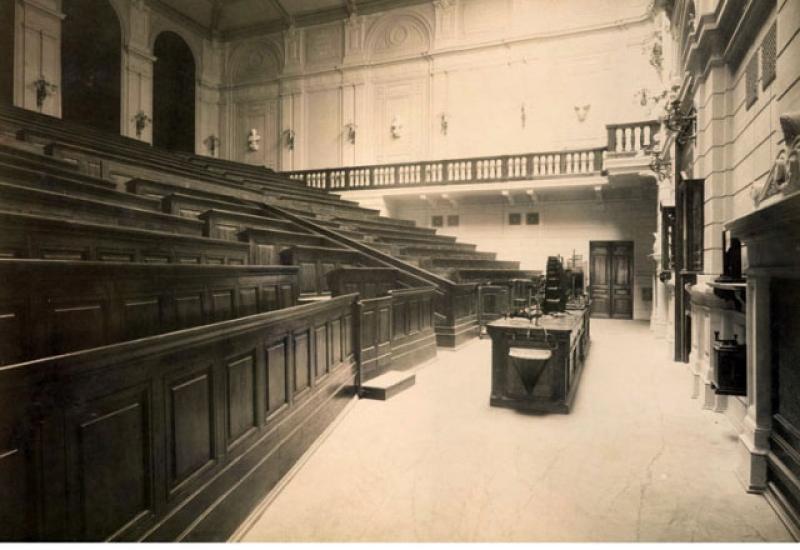Everyone knows the statements of the head of the first examination committee KPI - world-renowned scientist D.I. Mendeleev about the high level of training of graduates of the institute. These words were written in a memorandum to the Minister of Finance S.Y. Witte. Now they can be read on a plaque at the entrance to the first building. Mendeleev’s words in the same memorandum with the assessment of laboratories KPI are less known. He wrote: "I have seen most of the best laboratories in Western Europe, not to mention the laboratories of educational institutions of Russia. Classrooms and workshops KPI are different from anything I have ever seen, not only by modernity and wealth of equipment, but also by the variety and excellence of devices intended for student activities."
It is clear that such a high score - it is primarily assessment of those who organized laboratories, offices, workshops, and, of course, today is worth remembering how it happened. This is easy to do because the organizer of Physical Laboratory - Professor George G. De Metz published in 1903 a brochure where he described the facilities and laboratory equipment.
 G.G. De Metz (1861-1947) was at the very beginning of the Kiev Polytechnic. November 25, 1896, as a professor at the University of Kiev (from 1891), he participated in the first meeting of private entrepreneurs, engineers, university professors. As a result of this meeting a decision was voiced to establish in Kiev Polytechnic Institute. Subsequently, the Committee to collect donations requested De Metz manage the construction and furnishing of facilities for teaching and practical training of students of four branches of the future institute. Several times, De Metz remembered, architect I.S.Kittner, the author of the building KPI project, remodel projects Physical Laboratory, given the requirements of the customer. By the way, in the towers of the first building were built not only for beauty, but for the implementation of research requiring height; balconies on were made to install devices that require an open horizon. Corridor length of 42 meters is projected so that some physical experiments require considerable space. In addition, the doors and windows of adjacent premises with a corridor arranged so that opening them, you can get more distance in the horizontal direction.
G.G. De Metz (1861-1947) was at the very beginning of the Kiev Polytechnic. November 25, 1896, as a professor at the University of Kiev (from 1891), he participated in the first meeting of private entrepreneurs, engineers, university professors. As a result of this meeting a decision was voiced to establish in Kiev Polytechnic Institute. Subsequently, the Committee to collect donations requested De Metz manage the construction and furnishing of facilities for teaching and practical training of students of four branches of the future institute. Several times, De Metz remembered, architect I.S.Kittner, the author of the building KPI project, remodel projects Physical Laboratory, given the requirements of the customer. By the way, in the towers of the first building were built not only for beauty, but for the implementation of research requiring height; balconies on were made to install devices that require an open horizon. Corridor length of 42 meters is projected so that some physical experiments require considerable space. In addition, the doors and windows of adjacent premises with a corridor arranged so that opening them, you can get more distance in the horizontal direction.
Incidentally, the fact that what in our country is called physical laboratory, in Western Europe was called the Physics Institute. With respect to the KPI this includes the premise of the first building from the left tower up to energy wing with large physics auditorium inclusive.
Developing a task for architect De Metz based on the fact that students have to perform a lot of practical problems, they should be able to observe the phenomena and laws of nature and are not familiar with them only on dry descriptions or during demonstrations in lectures. Number of premises and equipment was determined based on the fact that the demonstration experiments during lectures did not interfere with practical training in the laboratory, and that there could be carried out and research.
De Metz described in detail the most interesting physical laboratory facilities, including large auditorium (now - Big physical audience), museum (the room where the instruments that were used during the lectures were kept), laboratory of precision measurements (with the best instruments and standards) cold laboratory (where, in particular, was the setting for the production of liquid air), student laboratory, optical-mechanical workshop, photographic pavilion.
De Metz wrote that he tried to gather in the lab all the best he had seen in foreign laboratories. And in the end proudly said that physics laboratory at the Kiev Polytechnic Institute is one of the best in Russia, and from major institutions of the West differs only in smaller sizes, not quality.

